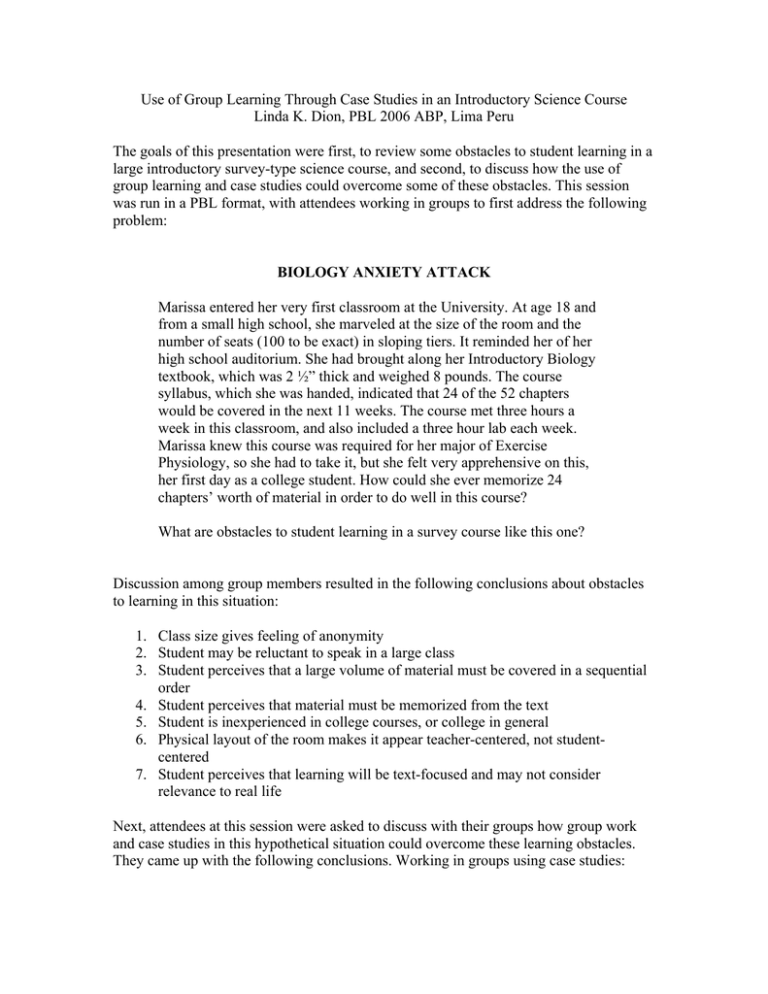Use of Group Learning Through Case Studies in an Introductory... Linda K. Dion, PBL 2006 ABP, Lima Peru
advertisement

Use of Group Learning Through Case Studies in an Introductory Science Course Linda K. Dion, PBL 2006 ABP, Lima Peru The goals of this presentation were first, to review some obstacles to student learning in a large introductory survey-type science course, and second, to discuss how the use of group learning and case studies could overcome some of these obstacles. This session was run in a PBL format, with attendees working in groups to first address the following problem: BIOLOGY ANXIETY ATTACK Marissa entered her very first classroom at the University. At age 18 and from a small high school, she marveled at the size of the room and the number of seats (100 to be exact) in sloping tiers. It reminded her of her high school auditorium. She had brought along her Introductory Biology textbook, which was 2 ½” thick and weighed 8 pounds. The course syllabus, which she was handed, indicated that 24 of the 52 chapters would be covered in the next 11 weeks. The course met three hours a week in this classroom, and also included a three hour lab each week. Marissa knew this course was required for her major of Exercise Physiology, so she had to take it, but she felt very apprehensive on this, her first day as a college student. How could she ever memorize 24 chapters’ worth of material in order to do well in this course? What are obstacles to student learning in a survey course like this one? Discussion among group members resulted in the following conclusions about obstacles to learning in this situation: 1. Class size gives feeling of anonymity 2. Student may be reluctant to speak in a large class 3. Student perceives that a large volume of material must be covered in a sequential order 4. Student perceives that material must be memorized from the text 5. Student is inexperienced in college courses, or college in general 6. Physical layout of the room makes it appear teacher-centered, not studentcentered 7. Student perceives that learning will be text-focused and may not consider relevance to real life Next, attendees at this session were asked to discuss with their groups how group work and case studies in this hypothetical situation could overcome these learning obstacles. They came up with the following conclusions. Working in groups using case studies: 1. Removes anonymity, provides identity in a large class, creates a small community for each student 2. Engages students in discussion; removes inhibitions 3. Provides instructor with opportunity to know students better (and vice versa) since instructor rotates among groups during class 4. Transfers focus from instructor to student 5. Illustrates relevance to real life, society in general 6. Bridges topics – looks at big picture rather than individual chapters in textbook 7. Goes beyond the “knowledge” level of learning 8. Provides instructor the opportunity to assess students’ understanding through informal interaction with groups Finally, attendees were given hand-outs of four case studies which could be used for group work in an Introductory Biology class. They broadly covered the topics of population ecology, digestion, neural physiology, and cell structure and transport. Their potential for adaptation to different PBL formats was emphasized.


